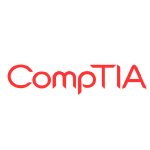COMPTIA SECURITY+ CERTIFICATION SUPPORT SKILLS (EXAM SYO-501)
Course Overview
CompTIA Security+ is a global certification that validates the baseline skills you need to perform core security functions and pursue an IT security career.
This course will teach you the fundamental principles of installing and configuring cybersecurity controls and participating in incident response and risk mitigation. It will prepare you to take the CompTIA Security+ SY0-501 exam by providing 100% coverage of the objectives and content examples listed on the syllabus. Study of the course can also help to build the prerequisites to study more advanced IT security qualifications, such as CompTIA Cybersecurity Analyst (CSA)+, CompTIA Advanced Security Practitioner (CASP), and ISC’s CISSP (Certified Information Systems Security Professional).

Course Objectives
Upon successful completion of this course, students will be able to:
- Identify strategies developed by cyber adversaries to attack networks and hosts and the countermeasures deployed to defend them.
- Understand the principles of organizational security and the elements of effective security policies.
- Know the technologies and uses of cryptographic standards and products.
- Install and configure network- and host-based security technologies.
- Describe how wireless and remote access security is enforced.
- Describe the standards and products used to enforce security on web and communications technologies.
- Identify strategies for ensuring business continuity, fault tolerance, and disaster recovery.
- Summarize application and coding vulnerabilities and identify development and deployment methods designed to mitigate them.
Course Prequisites
It is recommended that you have the following skills and knowledge before starting this course:
- Know the function and basic features of the components of a PC.
- Use Windows Server OS to create and manage files and use basic administrative features (Explorer, Control Panel, Server Manager, and Management Consoles).
- Operate the Linux OS using basic command-line tools.
- Know basic network terminology and functions (such as OSI Model, Topology, Ethernet, Wi-Fi, switches, routers).
- Understand TCP/IP addressing, core protocols, and troubleshooting tools.
Target Audience
CompTIA Security+ is aimed at IT professionals with job roles such as security engineer, security consultant / specialist, information assurance technician, junior auditor / penetration tester, security administrator, systems administrator, and network administrator.
Course Outline
Module 1 / Threats, Attacks, and Vulnerabilities
Indicators of Compromise
- Why is Security Important?
- Security Policy
- Threat Actor Types
- The Kill Chain
- Social Engineering
- Phishing
- Malware Types
- Trojans and Spyware
- Open Source Intelligence
- Labs
- VM Orientation
- Malware Types
Critical Security Controls
- Security Control Types
- Defense in Depth
- Frameworks and Compliance
- Vulnerability Scanning and Pen Tests
- Security Assessment Techniques
- Pen Testing Concepts
- Vulnerability Scanning Concepts
- Exploit Frameworks
- Lab
- Using Vulnerability Assessment Tools
Security Posture Assessment Tools
- Topology Discovery
- Service Discovery
- Packet Capture
- Packet Capture Tools
- Remote Access Trojans
- Honeypots and Honeynets
- Labs
- Using Network Scanning Tools 1
- Using Network Scanning Tools 2
- Using Steganography Tools
Incident Response
- Incident Response Procedures
- Preparation Phase
- Identification Phase
- Containment Phase
- Eradication and Recovery Phases
Module 2 / Identity and Access Management
Cryptography
- Uses of Cryptography
- Cryptographic Terminology and Ciphers
- Cryptographic Products
- Hashing Algorithms
- Symmetric Algorithms
- Asymmetric Algorithms
- Diffie-Hellman and Elliptic Curve
- Transport Encryption
- Cryptographic Attacks
- Lab
- Implementing Public Key Infrastructure
Public Key Infrastructure
- PKI Standards
- Digital Certificates
- Certificate Authorities
- Types of Certificate
- Implementing PKI
- Storing and Distributing Keys
- Key Status and Revocation
- PKI Trust Models
- PGP / GPG
- Lab
- Deploying Certificates and Implementing Key Recovery
Identification and Authentication
- Access Control Systems
- Identification
- Authentication
- LAN Manager / NTLM
- Kerberos
- PAP, CHAP, and MS-CHAP
- Password Attacks
- Token-based Authentication
- Biometric Authentication
- Common Access Card
- Lab
- Using Password Cracking Tools
Identity and Access Services
- Authorization
- Directory Services
- RADIUS and TACACS+
- Federation and Trusts
- Federated Identity Protocols
Account Management
- Formal Access Control Models
- Account Types
- Windows Active Directory
- Creating and Managing Accounts
- Account Policy Enforcement
- Credential Management Policies
- Account Restrictions
- Accounting and Auditing
- Lab
- Using Account Management Tools
Module 3 / Architecture and Design (1)
Secure Network Design
- Network Zones and Segments
- Subnetting
- Switching Infrastructure
- Switching Attacks and Hardening
- Endpoint Security
- Network Access Control
- Routing Infrastructure
- Network Address Translation
- Software-Defined Networking
- Lab
- Implementing a Secure Network Design
Firewalls and Load Balancers
- Basic Firewalls
- Stateful Firewalls
- Implementing a Firewall or Gateway
- Web Application Firewalls
- Proxies and Gateways
- Denial of Service Attacks
- Load Balancers
- Lab
- Implementing a Firewall
IDS and SIEM
- Intrusion Detection Systems
- Configuring IDS
- Log Review and SIEM
- Data Loss Prevention
- Malware and Intrusion Response
- Lab
- Using an Intrusion Detection System
Secure Wireless Access
- Wireless LANs
- WEP and WPA
- Wi-Fi Authentication
- Extensible Authentication Protocol
- Additional Wi-Fi Security Settings
- Wi-Fi Site Security
- Personal Area Networks
Physical Security Controls
- Site Layout and Access
- Gateways and Locks
- Alarm Systems
- Surveillance
- Hardware Security
- Environmental Controls
Module 4 / Architecture and Design (2)
Secure Protocols and Services
- DHCP Security
- DNS Security
- Network Management Protocols
- HTTP and Web Servers
- SSL / TSL and HTTPS
- Web Security Gateways
- Email Services
- S/MIME
- File Transfer
- Voice and Video Services
- VoIP
- Labs
- Implementing Secure Network Addressing Services
- Configuring a Secure Email Service
Secure Remote Access
- Remote Access Architecture
- Virtual Private Networks
- IPSec
- Remote Access Servers
- Remote Administration Tools
- Hardening Remote Access Infrastructure
- Lab
- Implementing a Virtual Private Network
Secure Systems Design
- Trusted Computing
- Hardware / Firmware Security
- Peripheral Device Security
- Secure Configurations
- OS Hardening
- Patch Management
- Embedded Systems
- Security for Embedded Systems
Secure Mobile Device Services
- Mobile Device Deployments
- Mobile Connection Methods
- Mobile Access Control Systems
- Enforcement and Monitoring
Secure Virtualization and Cloud Services
- Virtualization Technologies
- Virtualization Security Best Practices
- Cloud Computing
- Cloud Security Best Practices
Module 5 / Risk Management
Forensics
- Forensic Procedures
- Collecting Evidence
- Capturing System Images
- Handling and Analyzing Evidence
- Lab
- Using Forensic Tools § Disaster Recovery and Resiliency
- Continuity of Operations Plans
- Disaster Recovery Planning
- Resiliency Strategies
- Recovery Sites
- Backup Plans and Policies
- Resiliency and Automation Strategies
Risk Management
- Business Impact Analysis
- Identification of Critical Systems
- Risk Assessment
- Risk Mitigation
Secure Application Development
- Application Vulnerabilities
- Application Exploits
- Web Browser Exploits
- Secure Application Design
- Secure Coding Concepts
- Auditing Applications
- Secure DevOps
- Lab
- Identifying a Man-in-the-Browser Attack
Organizational Security
- • Corporate Security Policy
- • Personnel Management Policies
- • Interoperability Agreements
- • Data Roles
- • Data Sensitivity Labeling and Handling
- • Data Wiping and Disposal
- • Privacy and Employee Conduct Policies
- • Security Policy Training
What Our Students Have to Say


